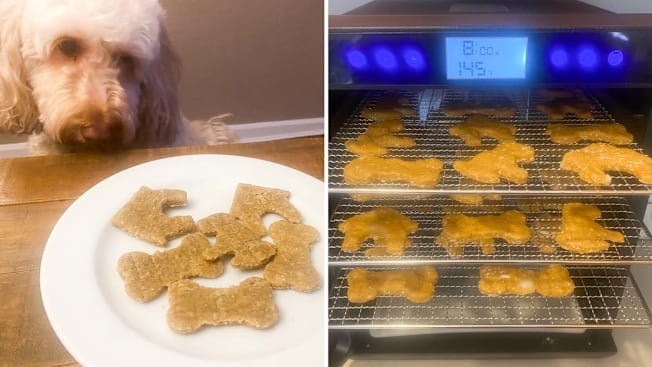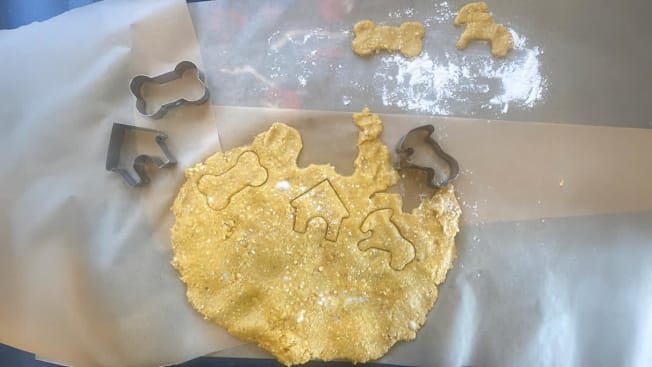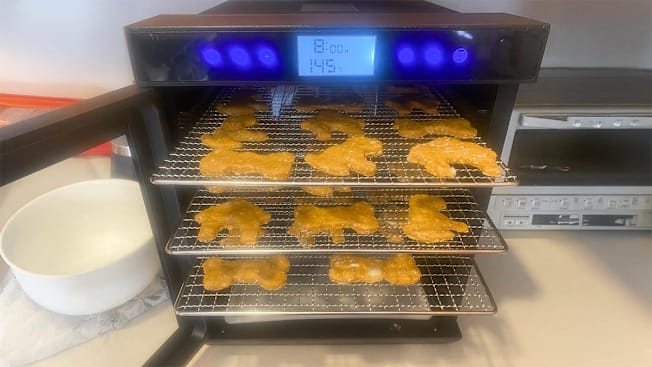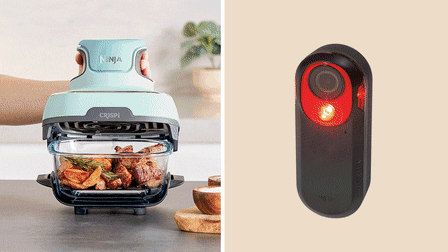The Easy Way to Make Dog Treats at Home
Homemade dog treats can be healthy, delicious—and intimidating. We tried a stress-free recipe in a dehydrator and made our Labradoodle, Blake, deliriously happy
When you shop through retailer links on our site, we may earn affiliate commissions. 100% of the fees we collect are used to support our nonprofit mission. Learn more.

Every time I pour a bowl of kibble for my six-year-old Labradoodle, Blake, or toss him a nasty-smelling dry treat, I think: There’s way better, fresher food out there. My desire to spend more money on higher-quality dog food and treats is high, and all of the subscription offers I receive from pricey pet food companies that deliver fresh, pre-portioned dog food to your door are tempting. But those membership fees? Not so fast.
The problem is that it’s challenging to know what’s really in our dog food. I like knowing exactly what I’m feeding Blake; the thought that I’m spending money on food and not getting excellent quality doesn’t sit well.
What's Really in Your Dog's Food?
CR tested 58 dog foods: here’s what we found out.

Photo: Lisa Fogarty/Consumer Reports Photo: Lisa Fogarty/Consumer Reports
And here’s how you, too, can make your dog deliriously happy by whipping up simple homemade dog treats without adding stress to your life.
Step One: Consider Your Dog’s Food Needs
Before you roll up your sleeves and make a big batch of homemade dog treats, it’s important to assess your dog’s personal health and food needs. If your dog is having any stomach upset, it is not a good time to introduce a new treat, Dr. Anna Kaufman, a veterinarian at Bond Vet, tells CR. “If your dog is on a special diet prescribed by your veterinarian, ask your dog’s doctor before introducing a new treat or chew to make sure it is a good idea,” Kaufman says.
The texture of your dog treats also matters; being mindful of our pet’s dental care is important to their overall health. “Your dog should not eat anything that is very hard as they could fracture a tooth or swallow a piece, which is a choking hazard,” Kaufman says. “I typically tell my clients to only give their dogs something soft enough that they could dent with their thumbnail.”
Finally, even if you worked really hard making those treats and they look as pretty as a picture, Kaufman advises not continuing to give them to your dog if your pup shows signs of stomach upset after sampling the new treat. Don’t worry: They will still appreciate your effort and love you for it.
Step Two: Invest in a Food Dehydrator
You can make dog treats in your oven, but if you’re on the fence about getting a food dehydrator because you’re curious about the many other foods it can dry that can save you money (like fruit leather, beef jerky, granola, yogurt, and dried herbs), I highly recommend it. An oven takes two to three times longer to dry foods than a dehydrator. It’s so much less stressful to place your dog treat dough into a dehydrator, set it at the recommended temperature and time, leave it alone, and actually go about your day doing other things. There’s no need to constantly check on the dough to ensure it isn’t burning, a dehydrator uses less energy than an oven, and, unlike an oven, it doesn’t add heat to your kitchen in the dead of summer.
I used the Magic Mill Food Dehydrator Machine, which we tried in a recent test. This dehydrator’s interface is simple to operate, it comes with 10 trays, and it utilizes horizontal airflow, which is considered more desirable than vertical airflow. After spacing out my dog treats on three trays (more specifics on that in a minute), I pushed three buttons—one to set the timer for eight hours, another to set the temperature to 145°F, and a third to start it—and then I forgot about the treats until it was time to flip them over halfway through. In the meantime, I got some reading done, folded laundry, went for a run, showered, and started dinner. Food dehydrators are a liberating appliance.
Best Food Dehydrators
We made beef jerky, fruit leather, and dried herbs in our tests
Step Three: Find a Dog-Safe Recipe
The internet is a wild place where you’ll find a considerable number of dog treat recipes, but not all of them will necessarily be safe. One of the first recipes I came across sounded great for Blake (though I can’t say I was over the moon about having to cook boiled chicken liver—the things we do for our pups). But one of the ingredients listed was garlic powder, which is a no-no according to Animal Poison Control. Other foods that your dog should avoid include:
• Alcohol/yeast dough
• Chocolate, coffee, and caffeine
• Avocado
• Citrus fruit
• Grapes and raisins
• Onion and chives
• Milk/dairy
• Nuts/fatty foods like coconut
• Raw, undercooked meats, eggs, and bones
• Xylitol sweetener
• Excessively salty foods
When I came across this recipe for dehydrated dog treats by Peel with Zeal, I was delighted: peanut butter, banana, and old-fashioned oats sound healthy and yummy, and I could make everything in one bowl. Best of all: If you don’t have a rolling pin, you can place the dough between parchment and press down onto the paper with a large pan to flatten out the dough. I used this method and can confirm it worked beautifully.
I cheated and used a hand mixer instead of mixing everything by hand, and my dough was soft, pliable, and ready to go. Even though the recipe calls for a 15-minute prep time, it took me 25 minutes to properly prep the dough and fashion it into shapes using cookie cutters.

Photo: Lisa Fogarty/Consumer Reports Photo: Lisa Fogarty/Consumer Reports
This leads me to my next step: Don’t rush the process.
Step Four: Make the Recipe
Brew yourself a cup of coffee and don’t make plans for 30 minutes (let’s be real: more like 45 minutes after you’re finished cleaning up). It’s less stressful to commit to the task of making homemade dog treats when you aren’t rushing things or trying to squeeze it into an already chore-packed day.
On a bright Sunday morning, with a home-brewed latte by my side, I added to a large mixing bowl four eggs, one mashed overripened banana, and ¼ cup of bacon grease that I retrieved after frying up a few strips of bacon while Blake smelled the aroma and salivated. The recipe also mentions that you can use coconut oil as a substitute, but I avoided it based on Animal Poison Control’s recommendations. I then added 1.5 cups of all-purpose flour, 1 cup of cornmeal (the recipe recommends almond flour, but I couldn’t find this at my local grocery store), 1 cup of old-fashioned oats, and 3 tablespoons of peanut butter, for which you can substitute almond butter to keep the treats peanut-free. The combined ingredients seemed a little thick to attempt to mix by hand, so I opted to use my electric mixer. A few minutes later, the dough was perfect.
I am not known for my dough-wielding skills, so I’m not pulling your leg when I tell you it was easy-peasy to spread parchment paper on my kitchen table, throw a little flour down to keep the dough from sticking, and spread the dough out with my hands—no rolling pin necessary.
I scored these adorable dog treat cookie cutters and used them to turn the dough into the shapes of dogs, bones, and dog houses. I was able to make 54 dog treats (admittedly, it would have been more had I used the rolling pin to thin out the dough). My final step was lightly spraying cooking spray on Magic Mill dehydrator racks, spacing the dog treats out on the racks, and sliding the racks into the dehydrator. I added Magic Mill’s crumb tray to the bottom of the dehydrator to pick up any dough debris that might fall through the racks.

Photo: Lisa Fogarty/Consumer Reports Photo: Lisa Fogarty/Consumer Reports
As per the recipe’s recommendation, I set the dehydrator to 145°F for eight hours. Four hours later, I stopped the dehydrator, flipped all of the treats over, and then reset the dehydrator for four hours at 145°F. After the full eight hours, the treats were cooked to perfection: slightly crispy on the outside and moist and chewy on the inside. Unlike all of the store-bought dog treats I’ve fed Blake over the years, these smelled wonderful.

Photo: Lisa Fogarty/Consumer Reports Photo: Lisa Fogarty/Consumer Reports
Step Five: Spoil Your Pup and Properly Store Treats
These dog treats were a hit with Blake, and I feel great knowing that each ingredient in them is healthy, safe, and something I would feed myself and my family.
According to the recipe, the treats can last three months at room temperature if stored in an airtight container. They can be frozen for an additional three months.




















